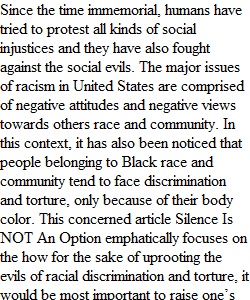


Q Effectiveness Analysis Papers 1 & 2 Instructions PURPOSE: The purpose of writing these papers is to give you practice and active participation in the rhetorical analysis process. Critical thinking about rhetoric comes from participating in, and actively doing analysis, over and over again. You will gain the experience of critical analysis from the Choice through the Evaluation stages of the rhetorical process (i.e. Rowland’s CARE stages). THE ASSIGNMENT: All papers must be typed and double spaced using 12 pt., Times New Roman font, with 1" margins only. Essays should be proofread and errors in typing, punctuation, spelling, and so on corrected. In terms of form, the student should follow the APA style manual (see suggested texts in the syllabus). Any material used in the paper which is not general knowledge should be cited in proper APA reference form (this includes the textbook, though it does not count as a source for your final source totals). A paper should be no longer than five (5) to six (6) typewritten pages, not including a title page and the works cited page. It should analyze only one rhetorical artifact of a limited size and length. It might be a taped or printed speech, an essay, editorial, letter to the editor, lyrics to a song, television commercial, or the like. Effectiveness Analysis Paper #2 must analyze rhetoric created after January 1st, of the previous year. It is strongly encouraged for you to begin looking for rhetorical artifacts immediately, so start reading immediately – and often! Both papers will consist of an analysis of the effectiveness of a work of rhetoric. You will utilize the “Outline of rhetorical and contextual analysis categories” outline sheet as the basis for your writing, as well as guidelines described in both the textbook and in class discussions. You should consult with the me to determine whether an item of rhetoric is suitable for a paper and I can also aid students in finding appropriate works for analysis, if need be. All rhetorical artifacts for papers must be approved in advance and the dates for getting rhetoric approved are on the syllabus. A COPY OF THE RHETORICAL ACT MUST BE TURNED IN ALONG WITH THE PAPER. A paper will not be graded if the rhetorical act is not turned in with the paper or if the act does not meet the date requirement. Citations: All papers require outside research. A paper without outside research does not, and cannot, fulfill the assignment requirements. A student must cite a minimum of six to eight relevant sources (any textbooks, including the one for this course, or un-reliable sources such as Wikipedia, Dictionary.com, About.com and the like do NOT qualify as sources. You may utilize these as resources only, but do not count toward your number of required sources). Also, the rhetorical artifact is NOT a source, as sources are used to support your claims of barriers/advantages that exists within the rhetorical artifact; therefore, the artifact itself cannot be a source. If you have any questions about the quality of the source, consult the resources on Canvas. If you have exhausted all your resource, contact me and I will help. Your paper must be submitted to Turnitin.com (Canvas). Failure to do both will result in your earning a zero for this assignment. See Canvas for specifics about due date and time. ? STRUCTURE/NOTES ON THE PAPER ASSIGNMENTS: 1. Introduction: - Establish the importance of the study (1 paragraph) - Explain why you are looking at the work - use the principles of choice (1 paragraph) 2. Main Body: (each letter would be another section- Make sure to include appropriate section headings for each A-D) A. Discussion of the dominant themes and requested actions - you need to cite evidence from the rhetoric to support your claims (about 2 paragraphs) B. Discussion of Barriers and Advantages - this will be largely based on your library research on the topic and most of your sources will be cited in this section (2 pgs.) C. Consideration of the Strategies used - Draw from your analysis of the rhetoric and quote the rhetoric for backing your claims (2 pgs.) D. Comparison of the strategies to the barriers and advantages - move from each barrier or advantage to the next barrier/advantage and show how the strategy works or fails to work - You are doing this in order to make an argument as to whether the rhetoric was effective or not. (about 1 page) 3. Conclusion: - Summarize your argument and draw conclusions about the effectiveness of the rhetoric. This section finalizes your claims about the effectiveness of the rhetoric in overcoming the barriers, holistically (about 2 paragraphs). ***Also, you must turn in a copy of the rhetoric, use 6-8 sources cited in APA format and also use 1" margins and a 12 pt. font***
View Related Questions